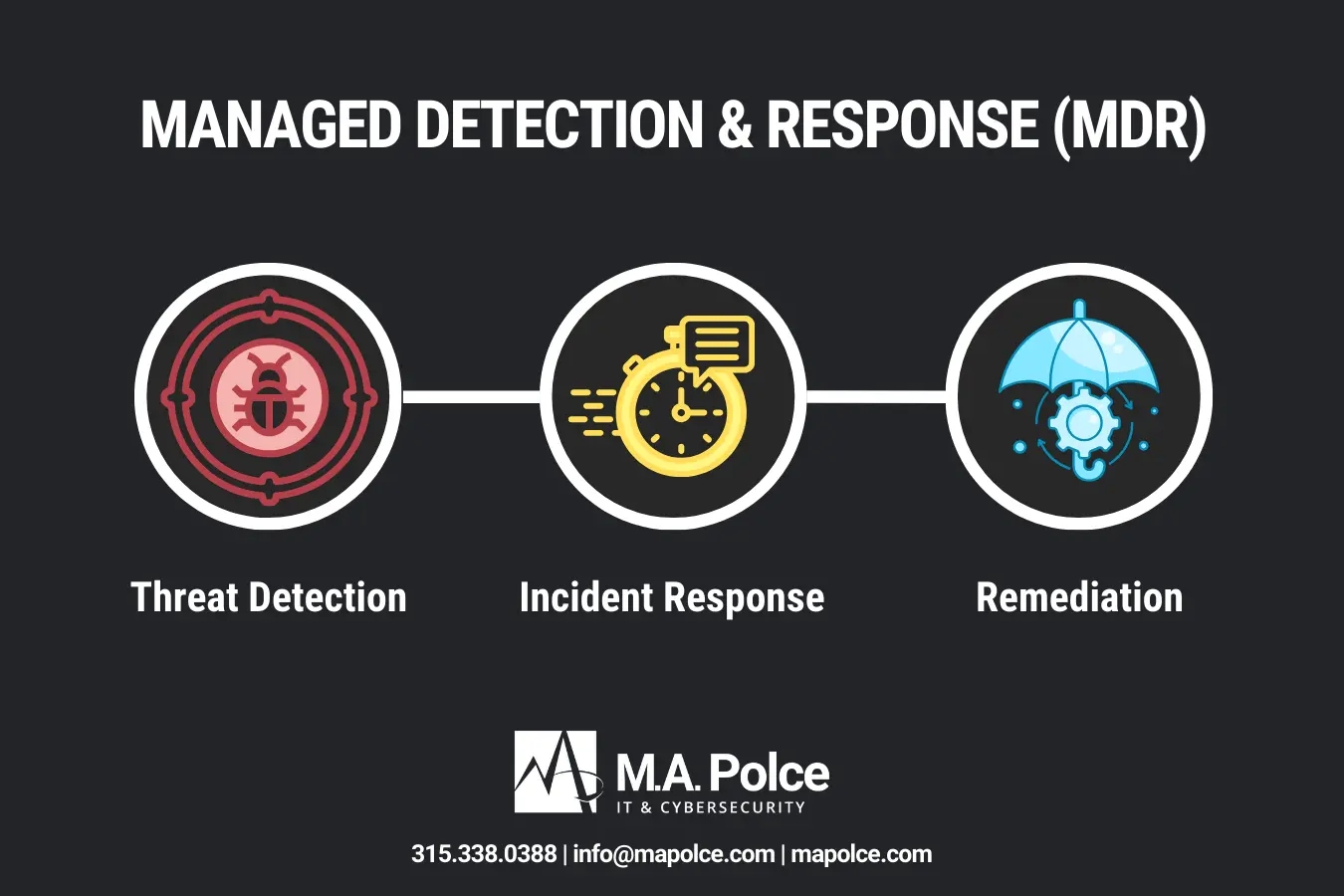MDR vs. EDR: What You Need to Know
There are many solutions for preventing cyber threats and enhancing IT security. Two of the most popular are managed detection and response (MDR) and endpoint detection and response (EDR). At their core, both MDR and EDR are looking for known signatures of malicious code and the anomalous behaviors that can result. The main difference between the two is that EDR is exclusively tool-based, while MDR incorporates both tools and humans. MDR also has the advantage of detecting tradecraft and other advanced attack techniques using artificial intelligence and real-time analysis by expert cyber professionals.
Every business is susceptible to cyberattacks. According to Deloitte’s 2023 Global Future of Cyber Survey, 91% of organizations of all cyber maturity levels cite at least one incident in 2022. However, not all businesses share the same concerns. Your company’s unique objectives and needs will determine if MDR or EDR is best. Compare the two cybersecurity solutions with M.A. Polce.
Pros and Cons of Managed Detection and Response (MDR)
MDR services are outsourced services that usually run out of security operations centers (SOCs). MDR providers use their expertise and resources to provide three basic solutions — threat detection, incident response, and remediation. They actively search for, contain, and assess cyber threats to minimize them before they can damage an organization’s IT systems.
The market for MDR services is quickly growing, and researchers expect it to stand at $21.9 billion by 2030. The many benefits of MDR explain this growth. For one, MDR services deliver 24/7 monitoring and response capabilities, which provide more visibility over an IT infrastructure than an internal team could manage alone. They also enable seamless scalability so businesses can manage the increasing demand for cybersecurity services without impacting their risk.
Perhaps the most significant advantage of MDR services is that they give businesses access to cybersecurity talent and advanced technologies. According to the World Economic Forum’s Global Cybersecurity Outlook 2023, the estimated shortage of cybersecurity experts stood at 2.27 million in 2021. Outsourcing MDR services allows businesses to obtain expertise from skilled security professionals more affordably.
Although MDR services are typically less expensive than hiring new staff and are better at stopping threats than EDR tools, they tend to cost more than EDR solutions. Additionally, businesses must work with a third party for MDR SOC services. For this reason, it’s best to choose a service provider with a well-known reputation, a dedicated security team, and the right certifications, such as SOC 2.
Pros and Cons of Endpoint Detection and Response
EDR technology monitors endpoints like computers, mobile devices, and servers, collecting and analyzing data related to security. When incidents appear, it investigates and isolates the attack if needed.
Unlike MDR, EDR is confined to software tool capabilities; no humans are involved. While EDRs do a decent job of detecting known signatures of malicious code, they do not have the same hunting and detection capabilities as an MDR service.
As mentioned, the biggest key benefit of EDR is cost. Since it only involves tools, EDR is generally more affordable than MDR. However, relying solely on EDR means an organization has limited visibility into its true threat level. EDR solutions often miss threats that MDR services pick up. Further, EDR tools cannot respond immediately to threats in the same way a dedicated SOC can.
MDR and EDR Work Well Together
Ultimately, services and tools like MDR and EDR all work toward one goal — enhancing security to protect your business. When paired, MDR and EDR provide a solid basis for detecting and mitigating threats.
Real-time, continuous monitoring and analysis make the threat intelligence of MDR second to none for cybersecurity services. MDR service providers utilize their own tools and often have the resources to provide the latest technology to protect networks, such as advanced analytics and machine learning. These capabilities enable proactive threat hunting, meaning service providers can predict how cybercriminals operate to respond to attacks before they impact IT infrastructure.
EDR tools are adept at preventing malicious activity and can be even more powerful when their telemetry is ingested into the MDR service for analysis. As such, the strongest cybersecurity strategies incorporate both solutions.
Enhance Cybersecurity with M.A. Polce
Whether you decide MDR or EDR is best for your operations, your goal should be maintaining a more proactive cybersecurity strategy. At M.A. Polce, our cybersecurity services include MDR and EDR services to help manage, secure, and modernize your organization. We’re a SOC 2-compliant managed services provider (MSP) and managed security services provider (MSSP) helping small to medium-sized businesses across New York State. Contact us today to learn more about our solutions and the industries we serve.
Sources:
https://www.connectwise.com/blog/cybersecurity/edr-vs-mdr
https://www.kaseya.com/blog/2023/04/06/managed-detection-and-response-mdr/
https://cyberdefenselabs.com/endpoint-detection-response-edr-vs-managed-detection-response-mdr/
https://corelight.com/resources/glossary/signature-based-detection




